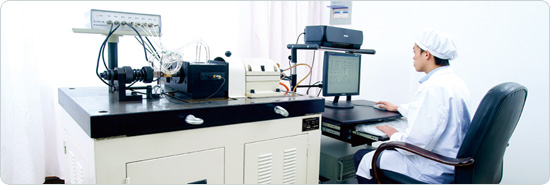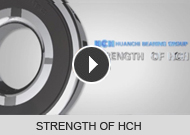Technical>Correction of basic load rating

Correction of basic load rating
● Correction due to temperature
The operating temperature will significantly affect the fatigue life by altering the hardness of the bearing. Consequently, the basic load rating, which depends on the physical properties of the bearing material, will decrease with higher temperatures. Thus, the basic load rating must be corrected for higher temperatures using the equation:

(2) Bearing characteristic coefficient a2
The bearing characteristic in relation to bearing life may differ according to bearing materials(steel types and their quality), and may be altered by production process, design, etc. In such cases, the bearing Iife calculation can be corrected using the bearing characteristic coefficient a2.
HCH has employed yacuum-degassed bearing steel as HCH standard bearing material. It has a significant effect on bearing life extension which was verified through studies at HCH laboratory. The basic dynamic load rating of bearings made of vacuum-degassed bearing steel is specified in the bearing specification table, taking the bearing characteristic coefficient as a2=1. For bearings made of special materials to extend fatigue life,the bearing characteristic coefficient is treated as a2>1
(3) Operating condition coefficient a3
When bearings are used under operating conditions which directly affect their service Iife including improper Iubrication, the service Iife calculation can be corrected by using a3. Under normal lubrication, the calculation can be performed with a3=1; and, under favorable Iubrication,with a3>1. ln the following cases, the operating condition coefficient is treated as a3<1 Operating lubricant of Iow kinematic viscosity (BalI bearing......13mm2/s or Iess, Roller bearing......20 mm2/s or Iess) Operation at very slow rotationaI speed (Product of rolling element pitch diameter and rotational speed is 10000 or Iess) Contamination of lubricant is expected Greater misalignment of inner and outer rings is present Note: Since a2 and a3 are inter-dependent, some calculations treat them as one coefficient,a23. Due to difficult of value determination, for most applications, a23=1
Fator ηc for contamination level
This factor was introduced to consider the contamination level of the lubricant in the bearing life calculation. The influence of contamination on bearing fatigue depends on a number of parameters including bearing size, relative lubricant film thickness, size and distribution of solid contaminant particles, types of contamination (soft, hard etc). The influence of these parameters on bearing life is complex and many of the parameters are difficult to quantify. It is therefore not possible to allocate precise values to ηc that would have general validity. However, some guideline values are provided in the following table.

Note:
1) This approach will probably indicate only an approximate value of the effective factor ηc for the contamination level of the application.
2) The scale for ηc refers only to typical solid contaminants, Contamination by water or other fluids detrimental to bearing life in not included.
In case of very heavy contamination ( ηc=0), failure will be caused by wear, the useful life of the bearing can be shorter than the rated life.
The operating temperature will significantly affect the fatigue life by altering the hardness of the bearing. Consequently, the basic load rating, which depends on the physical properties of the bearing material, will decrease with higher temperatures. Thus, the basic load rating must be corrected for higher temperatures using the equation:

| Bearing Temperature ℃ | ||||
| ≤150℃ | 175℃ | 200℃ | 250℃ | |
| Temperature Factor ft | 1.00 | 0.95 | 0.90 | 0.75 |
| (1) Reliability coeffcient a1 | Reliability coefficient | ||||||||||||||||||||
|
The table on the right side describes reliability coefficient, a1, which is necessary to obtain the corrected rating life of reliability greater than 90%. L10: Life rating, adjusted for fatigue life for 90% reliability. This may not satisfy all applications. For higher reliability requirements, L10 must be adjusted. |
|
||||||||||||||||||||
(2) Bearing characteristic coefficient a2
The bearing characteristic in relation to bearing life may differ according to bearing materials(steel types and their quality), and may be altered by production process, design, etc. In such cases, the bearing Iife calculation can be corrected using the bearing characteristic coefficient a2.
HCH has employed yacuum-degassed bearing steel as HCH standard bearing material. It has a significant effect on bearing life extension which was verified through studies at HCH laboratory. The basic dynamic load rating of bearings made of vacuum-degassed bearing steel is specified in the bearing specification table, taking the bearing characteristic coefficient as a2=1. For bearings made of special materials to extend fatigue life,the bearing characteristic coefficient is treated as a2>1
(3) Operating condition coefficient a3
When bearings are used under operating conditions which directly affect their service Iife including improper Iubrication, the service Iife calculation can be corrected by using a3. Under normal lubrication, the calculation can be performed with a3=1; and, under favorable Iubrication,with a3>1. ln the following cases, the operating condition coefficient is treated as a3<1 Operating lubricant of Iow kinematic viscosity (BalI bearing......13mm2/s or Iess, Roller bearing......20 mm2/s or Iess) Operation at very slow rotationaI speed (Product of rolling element pitch diameter and rotational speed is 10000 or Iess) Contamination of lubricant is expected Greater misalignment of inner and outer rings is present Note: Since a2 and a3 are inter-dependent, some calculations treat them as one coefficient,a23. Due to difficult of value determination, for most applications, a23=1
Fator ηc for contamination level
This factor was introduced to consider the contamination level of the lubricant in the bearing life calculation. The influence of contamination on bearing fatigue depends on a number of parameters including bearing size, relative lubricant film thickness, size and distribution of solid contaminant particles, types of contamination (soft, hard etc). The influence of these parameters on bearing life is complex and many of the parameters are difficult to quantify. It is therefore not possible to allocate precise values to ηc that would have general validity. However, some guideline values are provided in the following table.

Note:
1) This approach will probably indicate only an approximate value of the effective factor ηc for the contamination level of the application.
2) The scale for ηc refers only to typical solid contaminants, Contamination by water or other fluids detrimental to bearing life in not included.
In case of very heavy contamination ( ηc=0), failure will be caused by wear, the useful life of the bearing can be shorter than the rated life.




